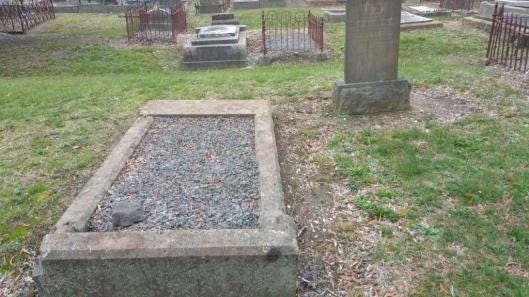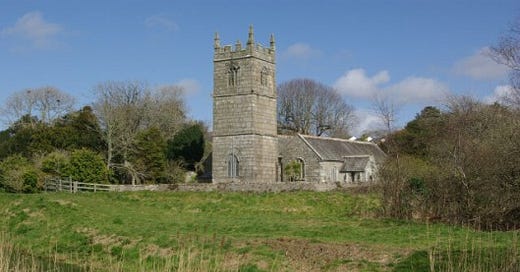My husband’s third great grandfather was Thomas Edwards (1794-1871), the son of John Edwards and Jane Edwards née Harvey. Thomas was baptised on 6 July 1794 at Towednack, Cornwall.
On 14 March 1826 Thomas married Mary Gilbart (1805-1867) in the parish church of St Erth. Thomas was about thirty-two. The witnesses were John Gilbart and Sarah Gilbart, both of them probably relatives of the bride.

Thomas and Mary’s first child, a son, Thomas was baptised at St Erth on 27 August 1826.
On the 1841 census Thomas was listed as a carpenter living with his wife Mary and five children at Bridge Terrace St Erth.
Francis Gilbart Edwards, youngest of the nine children of Thomas and Mary, was born 21 January 1848 at St Erth and baptised on 11 June 1848 at the parish church.
Shortly after the birth of Francis, the family emigrated to Victoria. They sailed on the Lysander from Plymouth on 21 September 1848 reaching Port Phillip on 13 January 1849.
In 1837 Mary’s sister Sarah (1808-1854) had married Francis Tuckfield (1808-1865), a Methodist missionary to the Aborigines at Buntingdale, near Geelong. The Tuckfields, who had been in the colony since 1838, may well have encouraged the Edwards to emigrate.
The passenger list of the Lysander shows the Edwards family was Wesleyan, with their native place given as St Ives. Thomas was 53, occupation wheelwright. Mary was 43. The passenger list records that they were accompanied by:
Thomas, age 22, farm labourer
John, age 19, mason
Elisabeth, age 17, nursemaid
James, age 13
Mary, age 11
William, age 9
Benjamin, age 5
Francis, infant
The older children could both read and write, William and Benjamin could read. One child, Francis, had died at St Erth in 1844 at the age of 3.
A family history compiled in 1964 by Thomas and Mary’s grandson Frederick James Edwards gives this account of their arrival and settlement in Victoria, from 1860 at Bullarook in the shire of Bungaree near Ballarat:
The time taken by the ship from Plymouth to Geelong was about 100 days. This ship “Lysander” of 475 tons had 238 passengers and there were 9 births and 7 deaths on the passage. The ship had one more trip to England for immigrants and bought back to Victoria the documents signed by Queen Victoria for the separation of N.S.W. from Victoria in 1851. It was then fitted out as a hospital ship and acted in that capacity for many years and acted as a Hospital Ship at the Crimean War.
The Victorian Government paid all shipping freight for tradesmen on all tools used by the trade. We have an anvil forged made and steel faced at the farm, brought out under those conditions.
The hardships of landing in a new country with no housing and a big family can be imagined. The father was a wheel right and carpenter and the eldest boys were also in the trade. And in Geelong, while there was plenty of work, later James with the eldest brother Thomas, who stayed with James and worked together through life, followed the gold rush without success, and then went farming at Little River, Buninyong and Bullarook where they stayed 14 years.
The farm at Bullarook proved quite a good farm, potatoes were the main crop. As the open up the land cry was on, and all the Western District was taken up they decided to select at Charlton. When the parents grew old they went to Bullarook with Thomas and James and died there and are buried in the old Ballarat cemetery, The years at Bullarook was 1860 to 1874 with the sale of the Bullarook land at £10 per acre gave Thomas and James a little money to start at Charlton. The finding of gold in Victoria brought thousands of immigrants from overseas and the service [surface] gold soon worked out and selectors took up land going north as the Western District was already taken over by squatters. These dates were from 1853 to 1870.On 11 August 1867 Mary Edwards née Gilbart died at Bungaree of a disease of the womb aged 61 years. She was buried in Ballarat cemetery.
On 7 January 1871 Thomas died suddenly, of “congestion of the brain” at Bungaree. An inquest was held two days later. Thomas was buried with Mary in Ballarat.

Related posts
Edwards family immigration on the Lysander arriving in the Port Phillip District in 1849
History of the Edwards Family page 1: compiled in 1964 by Thomas’s grandson
John and Jane Edwards of St Erth: identifying Thomas’s parents
F is for Francis, Thomas’s son and Greg’s great great grandfather (A to Z 2018)
E is for Edith, Thomas’s granddaughter and Greg’s great grandmother (A to Z 2025)
Wikitree: Thomas Edwards (1794-1871)
1. Greg is the son of Marjorie (Sullivan) Young
2. Marjorie is the daughter of Stella Esther Gilbart (Dawson) Sullivan (1894-1975)
3. Stella is the daughter of Edith Caroline (Edwards) Dawson (1871-1946)
4. Edith is the daughter of Francis Gilbart Edwards (1848-1913)
5. Francis is the son of Thomas Edwards (abt.1794-1871)
This makes Thomas the third great grandfather of Greg.
This post first published at https://anneyoungau.wordpress.com/2025/04/23/t-is-for-thomas/


It would be easier to move with half the children grown instead of all under ten.kristin
I loved reading that story vignette by Frederick Edwards - it was like stepping back in time!